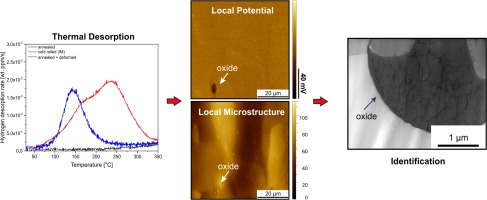当前位置:
X-MOL 学术
›
Acta Mater.
›
论文详情
Our official English website, www.x-mol.net, welcomes your feedback! (Note: you will need to create a separate account there.)
Spatially resolved localization and characterization of trapped hydrogen in zero to three dimensional defects inside ferritic steel
Acta Materialia ( IF 9.4 ) Pub Date : 2018-02-01 , DOI: 10.1016/j.actamat.2017.10.066 Waldemar Krieger , Sergiy V. Merzlikin , Asif Bashir , Agnieszka Szczepaniak , Hauke Springer , Michael Rohwerder
Acta Materialia ( IF 9.4 ) Pub Date : 2018-02-01 , DOI: 10.1016/j.actamat.2017.10.066 Waldemar Krieger , Sergiy V. Merzlikin , Asif Bashir , Agnieszka Szczepaniak , Hauke Springer , Michael Rohwerder

|
Abstract In this work, localized hydrogen (H) detection measurements were conducted on a model ferritic (Fe 5 wt.-% Ni) steel which enables a systematic study of 0- (vacancies), 1- (dislocations), 2- (grain boundaries) and 3- (inclusions) dimensional defects, induced by varying mechanical and thermal treatments, without changing the chemical composition of the material. Spatially resolved detection with Scanning Kelvin Probe Force Microscopy (SKPFM) as an electrochemical technique with a resolution on a nanometric scale in combination with Thermal Desorption Spectroscopy (TDS) and microstructure characterization using electron microscopy indicated a domination of at least two trapping sites. Step by step the dominating H trapping sites were identified as dislocations and vacancies with estimated desorption energies of 29 ± 5 and 38 ± 5 kJ mol −1 . Furthermore, voids, inclusions and their interface to the matrix where found to be trapping sites binding low amounts of H, invisible for TDS measurements but detectible with SKPFM. Unexpectedly, no H was detected inside high angle grain boundaries. This study shows that dislocation and vacancies are the main trapping sites whereas vacancies getting increasingly important after cold rolling of steel rich of inclusions. Furthermore, the importance of using several techniques to understand the trapping behaviour of H even in simplified model alloys is underlined.
中文翻译:

铁素体钢内零至三维缺陷中俘获氢的空间分辨定位和表征
摘要 在这项工作中,对模型铁素体(Fe 5 wt.-% Ni)钢进行了局部氢 (H) 检测测量,该钢能够系统地研究 0-(空位)、1-(位错)、2-(晶粒边界)和 3-(夹杂物)尺寸缺陷,由不同的机械和热处理引起,而不会改变材料的化学成分。使用扫描开尔文探针力显微镜 (SKPFM) 作为具有纳米级分辨率的电化学技术与热解吸光谱 (TDS) 和使用电子显微镜的微观结构表征相结合的空间分辨检测表明,至少有两个捕获位点占主导地位。逐步确定占主导地位的 H 捕获位点为位错和空位,估计解吸能量为 29 ± 5 和 38 ± 5 kJ mol -1 。此外,空隙、夹杂物及其与基质的界面被发现是结合少量 H 的捕获位点,对于 TDS 测量是不可见的,但可以用 SKPFM 检测到。出乎意料的是,在大角度晶界内没有检测到 H。这项研究表明,位错和空位是主要的俘获点,而在冷轧富含夹杂物的钢后,空位变得越来越重要。此外,强调了使用多种技术来理解 H 的俘获行为的重要性,即使在简化的模型合金中也是如此。这项研究表明,位错和空位是主要的俘获点,而在冷轧富含夹杂物的钢后,空位变得越来越重要。此外,强调了使用多种技术来理解 H 的俘获行为的重要性,即使在简化的模型合金中也是如此。这项研究表明,位错和空位是主要的俘获点,而在冷轧富含夹杂物的钢后,空位变得越来越重要。此外,强调了使用多种技术来理解 H 的俘获行为的重要性,即使在简化的模型合金中也是如此。
更新日期:2018-02-01
中文翻译:

铁素体钢内零至三维缺陷中俘获氢的空间分辨定位和表征
摘要 在这项工作中,对模型铁素体(Fe 5 wt.-% Ni)钢进行了局部氢 (H) 检测测量,该钢能够系统地研究 0-(空位)、1-(位错)、2-(晶粒边界)和 3-(夹杂物)尺寸缺陷,由不同的机械和热处理引起,而不会改变材料的化学成分。使用扫描开尔文探针力显微镜 (SKPFM) 作为具有纳米级分辨率的电化学技术与热解吸光谱 (TDS) 和使用电子显微镜的微观结构表征相结合的空间分辨检测表明,至少有两个捕获位点占主导地位。逐步确定占主导地位的 H 捕获位点为位错和空位,估计解吸能量为 29 ± 5 和 38 ± 5 kJ mol -1 。此外,空隙、夹杂物及其与基质的界面被发现是结合少量 H 的捕获位点,对于 TDS 测量是不可见的,但可以用 SKPFM 检测到。出乎意料的是,在大角度晶界内没有检测到 H。这项研究表明,位错和空位是主要的俘获点,而在冷轧富含夹杂物的钢后,空位变得越来越重要。此外,强调了使用多种技术来理解 H 的俘获行为的重要性,即使在简化的模型合金中也是如此。这项研究表明,位错和空位是主要的俘获点,而在冷轧富含夹杂物的钢后,空位变得越来越重要。此外,强调了使用多种技术来理解 H 的俘获行为的重要性,即使在简化的模型合金中也是如此。这项研究表明,位错和空位是主要的俘获点,而在冷轧富含夹杂物的钢后,空位变得越来越重要。此外,强调了使用多种技术来理解 H 的俘获行为的重要性,即使在简化的模型合金中也是如此。

























 京公网安备 11010802027423号
京公网安备 11010802027423号